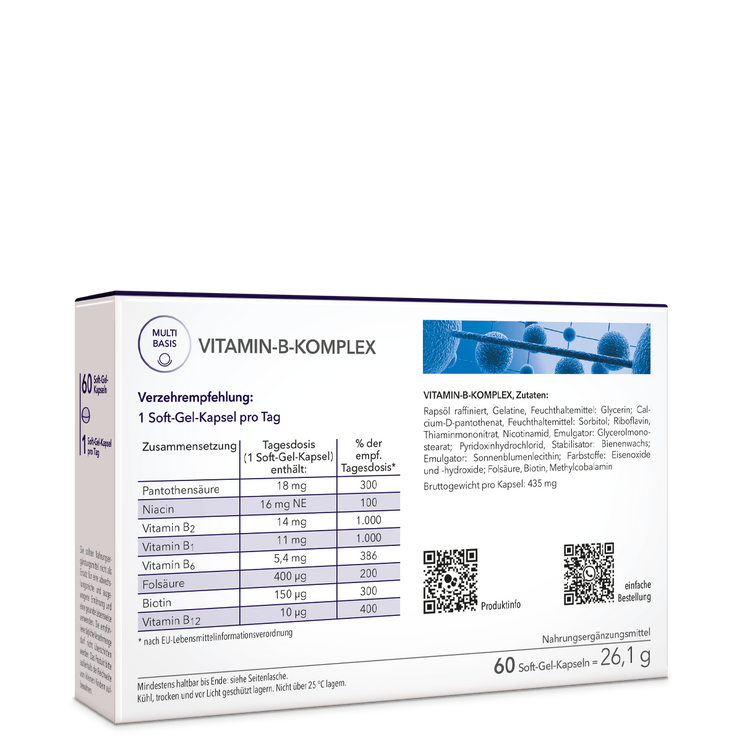Vitamin B3 (niacin): protection and energy for the nerves
-
The vitaminniacinbelongs to theVitamin B complexand is also known under the namesVitamin B3, nicotinic acid or alsoPP factor, since niacin deficiency diseasePellagraNiacin is important for the build-up and breakdown ofCarbohydrates,Proteins and fatsand plays a major role in a healthydigestion, a normalCholesterol metabolism, the Control of theBlood sugar, theHormone productionin the adrenal glands, germ and thyroid glands and theSkin health. In addition, niacin is used toEnergy generationneeded and positively influences themental and spiritual well-being.
Which foods contain niacin?
In food, niacin is found asNicotinic acidorNicotinamideBoth have nothing to do with the toxic alkaloid contained in tobacconicotineFish, poultry, beef, eggs, dairy products, coffee, peanuts, brown rice, whole wheat bread, wheat germ and yeast all contain high levels of niacin.
Origin and function of niacin
Niacin was first discovered inYear 1936and is thus a relatively young member of theVitamin B complex. Originally as a vitamin PP or vitamin PPF, it was later added to theB-Groupbecause, like the other B vitamins, it isCofactor of enzymesIn food, niacin occurs as nicotinic acid or nicotinamide. In the body, niacin is converted intoCoenzymes NAD and NADPThese are able to bind or release hydrogen. In doing so, they support certain enzymes that are particularly active inCarbohydrate, fat and protein metabolismplay an important role. The B vitamin is also important for theskin, because it helps with theCollagen and pigment formation. Niacin is also involved in the formation ofNeurotransmittersinvolved, which facilitates the transmission of stimuli in theNervous systemsteer.
When does the body need additional niacin?
At aShortageof niacin canfollowing symptomsappear:
Changes in the mucous membranesof the mouth and tongue (swollen and sometimes inflamed tongue).
Loss of appetite, dizziness, vomiting,constipationor diarrhea.
Nervous changesHow sleep disorders, fatigue, dizziness and headaches, as well as confusion and depression.
The clinical picture Pellagrawith symptoms such as diarrhea, skin diseases, fever,nervous disorders and dementia.
Am I lacking niacin?
Already ata relevant pointYour supply of niacin may be too low:
- Eat littleWhole grain products and legumes?
- Eatno or little fish?
- Eatvegan?
- Do you suffer from diseases of theDigestive tract?
Use of Niacin
If there is a correspondingly increased need for niacin due toEating habitsorDiseasescannot be covered, it is recommended to take niacin as a dietary supplement.too high dosageof more than 35 mg can lead to the so-calledNiacin flusha hot flush triggered by taking the vitamin, which is due to a short-term increase inBlood circulation in the skinThe cause of this phenomenon is the release of vasodilating prostaglandin D2 (PGD2) in the skin.
How much niacin does the body need?
TheGerman Nutrition Society (DGE)recommends different amounts of niacin depending on age and gender. Men between 25 and 65 years of age need15 mg niacinper day, whereas women between 25 and 51 yearsonly 12 mg niacin.Women over 51 yearsa daily dose of11mgrecommended.Pregnant womenhowever, need14 mg niacin, in the third trimester of pregnancy and at the end of breastfeeding, the recommended daily dose is even16mg. The need is met partly through food and partly through the body's own production. amino acidL-tryptophanas a starting material. From 60 mg tryptophan the body can1 mg niacinFor this process, the organism also needsProtein, vitamin B2,B6andFolic acidThe daily dose of niacin in adults should35mgnot exceed.
-

Order via WhatsApp
+49 152 587 587 54 -

We deliver
guaranteed in 2 days -

90 days
Refund warranty -

Free Shipping
Germany-wide from € 15,-








